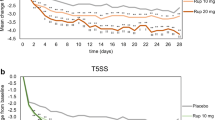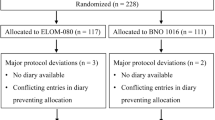Abstract
Many common treatments for rhinitis symptoms are inadequate or ineffective. This may be in part because the drug does not address the pathologically altered mechanism of the rhinopathy. Objective measures may not detect treatment effects, or the treatment end points may be only subjective in nature. In many cases, these issues have not arisen because of potent placebo effects. Understanding the psychological, pharmacologic, and physiologic components of placebos is important for separating true treatment effects from those of the excipients in the vehicle. Separating the wasteful and potentially harmful effects of those excipients from the harmless and often partially beneficial effects on temporary symptom control is an important issue in clinical pharmacology that can aid in effective clinical trial design, use of objective and subjective test measures, and development of drugs to treat rhinitis.
Similar content being viewed by others
References and Recommended Reading
Eccles R: Mechanisms of the placebo effect of sweet cough syrups. Respir Physiol Neurobiol 2006, 152:340–348.
Pavesi L, Subburaj S, Porter-Shaw K: Application and validation of a computerized cough acquisition system for objective monitoring of acute cough-a meta-analysis. Chest 2001, 120:1121–1128.
Eccles R: The powerful placebo in cough studies. Pulm Pharmacol Ther 2002, 15:303–308.
Harrington A: The Placebo Effect: An Interdisciplinary Approach. Cambridge, MA: Harvard University Press; 1999.
Mills SY: The House of Lords report on complementary medicine: a summary. Complement Ther Med 2001, 9:34–39.
Astin JA, Harkness E, Ernst E: The efficacy of “distant healing”: a systematic review of randomized trials. Ann Intern Med 2000, 132:903–910.
Beecher H: The powerful placebo. JAMA 1955, 159:1602–1606.
Kienle G, Kiene H: Placebo effect and placebo concept: a critical methodological and conceptual analysis of reports on the magnitude of the placebo effect. Altern Ther Health Med 1996, 2:39–54.
Kienle GS, Kiene H: The powerful placebo effect: fact or fiction? J Clin Epidemiol 1997, 50:1311–1318.
Sauro MD, Greenberg RP: Endogenous opiates and the placebo effect. A meta-analytic review. J Psychosom Res 2005, 58:115–120.
Giesecke T, Williams DA, Harris RE, et al.: Subgrouping of fibromyalgia patients on the basis of pressure-pain thresholds and psychological factors. Arthritis Rheum 2003, 48:2916–2922.
Spector SL: The placebo effect is nothing to sneeze at. J Allergy Clin Immunol 1992, 90:1042–1043.
Spector SL, Toshener D, Gay I, Rosenman E: Beneficial effects of propylene and polyethylene glycol and saline in the treatment of perennial rhinitis. Clin Allergy 1982, 12:187–196.
Vozeh S: Is the increasing use of evidence-based pharmacotherapy causing the renaissance of complementary medicine? Br J Clin Pharmacol 2003, 56:292–296.
Patulin Clinical Trials Committee, Medical Research Council: Clinical trial of patulin in the common cold. 1944. Int J Epidemiol 2004, 33:243–246.
Ernst E, Resch KL: Concept of true and perceived placebo effects. BMJ 1995, 311:551–553.
Jain R, Mukherjee K, Singh R: Influence of sweet tasting solutions on opioid withdrawal. Brain Res Bull 2004, 64:319–322.
Raphael G, Raphael MH, Kaliner M: Gustatory rhinitis: a syndrome of food-induced rhinorrhea. J Allergy Clin Immunol 1989, 83:110–115.
Lee PC, Jawad MS, Hull JD, et al.: The antitussive effect of placebo treatment on cough associated with upper respiratory infection. Psychosom Med 2005, 67:314–317.
Evans D: Placebo. The Belief Effect. London: Harper Collins; 2003.
Benedetti FAM: The neurobiology of placebo analgesia: from endogenous opioids to cholecystokinin. Prog Neurobiol 1997, 52:109.
Kenia P, Houghton T, Beardsmore C: Does inhaling menthol affect nasal patency or cough? Pediatr Pulmonol 2008, 43:532–537.
Ramsay J, Wright C, Thompson R, et al.: Assessment of antitussive efficacy of dextromethorphan in smoking related cough: objective vs. subjective measures. Br J Clin Pharmacol 2008, 65:737–741.
Sapci T, Yazici S, Evcimik MF, et al.: Investigation of the effects of intranasal botulinum toxin type A and ipratropium bromide nasal spray on nasal hypersecretion in idiopathic rhinitis without eosinophilia. Rhinology 2008, 46:45–51.
Jones NS: Midfacial segment pain: implications for rhinitis and sinusitis. Curr Allergy Asthma Rep 2004, 4:187–192.
Naranch K, Park Y-J, Repka-Ramirez SM, et al.: A tender sinus does not always mean sinusitis. Otolaryngol Head Neck Surg 2002, 127:387–397.
Shusterman D, Murphy MA: Nasal hyperreactivity in allergic and non-allergic rhinitis: a potential risk factor for non-specific building-related illness. Indoor Air 2007, 17:328–333.
Elsheikh MN, Badran HM: Dysautonomia rhinitis: associated otolaryngologic manifestations and characterization based on autonomic function tests. Acta Otolaryngol 2006, 126:1206–1212.
Author information
Authors and Affiliations
Corresponding author
Rights and permissions
About this article
Cite this article
Baraniuk, J.N. The placebo effect: Plugging the nostrils of unmet needs. Curr Allergy Asthma Rep 9, 149–152 (2009). https://doi.org/10.1007/s11882-009-0022-5
Published:
Issue Date:
DOI: https://doi.org/10.1007/s11882-009-0022-5




